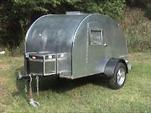Making a good joint
52 posts
• Page 4 of 4 • 1, 2, 3, 4
Would the previous suggestions work for 1/2 ply as well?
If I could shut my brain off, I could save myself alot of time, money and effort.
-

Aaron Coffee - 1000 Club

- Posts: 1003
- Images: 26
- Joined: Thu Jun 30, 2005 4:40 pm
- Location: Elk Point, SD
madjack wrote:I LOVE POCKET SCREWS...however, never used 'em for a butt joint to extend ply...if I did, I would want to put them in from both directions...one side/one way on one sheet and the opposite side/direction on the other piece with a screw placed at about 2"s apart(staggered from side to side) and I would probably want to use some thickened epoxy as well.........
madjack
It’s a problem generally screwing into end grain of plywood. The screws put pressure that tries to separate the different layers and it will split (inter-laminar tension failure) – it’s the weakest direction for strength in plywood.
-

kennyrayandersen - 1000 Club

- Posts: 1750
- Images: 38
- Joined: Sun Apr 29, 2007 10:27 pm
- Location: TX




